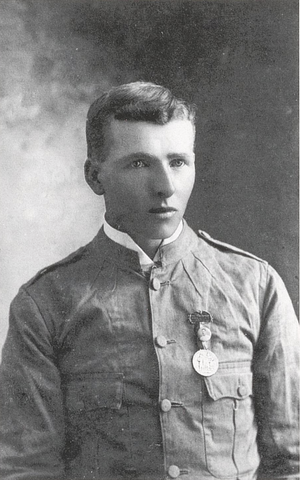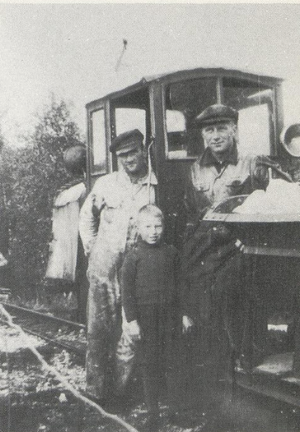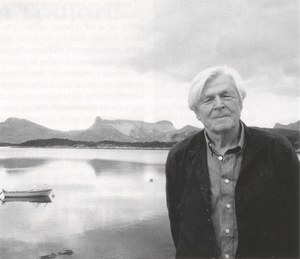Report from Tysfjord
This is a re-publication of articles that were previously published in Årbok for Tysfjord (Yearbook for Tysfjord) about Hamarøy's mining history.
Original article
Writer
Article in Norwegian
Report from Tysfjord
In 1926/27, Hans C. Mamen was a substitute manager of Drag feldspar mines in Tysfjord, Nordland. In May 1927, he sent a greeting to his hometown newspaper, "Asker and Bærums Budstikke," describing life and nature in Tysfjord. His son, Hans Chr. Mamen, who served as a substitute priest in Tysfjord during the 1990s, shares this historical account and his own memories of the village. Hans Chr. Mamen reflects on his father's descriptions and his personal experiences in a vivid narrative about an area characterized by majestic nature and rich cultural experiences.
Tysfjord in Nordland
Former farmer in Hvalstad, Mr. Hans C. Mamen, has sent us the following letter from Tysfjord where he is now managing the Drag mines. This village is probably not well known to many from Asker and Bærum, although it is 100 kilometers long and also wide, but it is so far north and inland. Tysfjord stretches from Vestfjorden right up to the Swedish border and has previously been hidden away, where nature has dominated both forest and land and also people. Here in the vast mountain ranges, bears and wolves lived in peace for the longest time; now these animals are also a rarity here. However, there are polar foxes and an unusually large amount of wildlife, hares, and grouse as well as capercaillie. I do not know the population number, but the municipal budget is about 130,000 kroner, and people were horrified by the large amount. A road is now being built here. About 5 to 6 years ago, the first road was built here in the village, Sørkil - Korsnes, about 20 km. Closest to the sea live the local people (Norwegian), further into the fjord mostly just Sami. About 5 km from here lies Fredly, the Sami mission's home, where three sisters (German deaconesses) perform a great and good deed, especially among the poor Sami, but also among the Norwegian population. If someone is sick, they go to Sister Rikke first and foremost; it is so reassuring. First, she is skilled with medicine, and secondly, it is the spiritual work she is engaged in. Last fall, there was much illness here, and Sister Rikke stayed up almost every night for a month, but then she also collapsed. As a small example of her work, I will tell a little episode: "Late one evening in November, in the rain and dark, I saw a person coming with a lantern, it was Rikke. She told me she had been out in the wilderness to visit the sick at the Sami camp. She had wandered out there for 3 hours but could not find the house. There was only one, and now she had to give up.”
The workers up here are also not as demanding as those in the south, and in addition, they are skilled and good workers who are pleasant to deal with, but there is a lot of poverty. Most have houses and are homeowners, but they use the land so terribly poorly. There are thousands of acres of good land here, well-suited for hay production at least, but they buy hay from Trondheim, and the freight is 8 øre per kg. All the cows are spring-calvers, and in winter they are out of milk. They do not like to work the land, but if they can get paid work, they are very willing. A Sami who lives 50 km further into the fjord rowed here and helped load a boat for a couple of days; he earned 13.57 kroner, then he had to row back home in a gale and rain, but he was satisfied with the earnings. The same boy lost his father in the winter; he had gotten lost in the mountains in a snowstorm. "The lad," as they say, just said: "We will find him in the spring when the snow melts if the fox doesn’t get him first.” We got a Ford locomotive here; this many found strange, and they stepped aside when I climbed up and drove. A woman closed her eyes. She was sure it would go wrong, but when I had driven, and it went well, she said: "Isn't it awful what people come up with these days." Cod (Lofoten cod) is standing - 40 to 50 øre each with roe and liver in. Liver, yes, it is a pity we do not get any of it in the south; one could thereby save a lot of cod liver oil in the form of liver, the oil is a delicacy one must search long for.
I do not suffer from writer's itch, but a Sunday can be quite long when you live in a big house all alone without having a single place to go, and therefore I thought I would send a greeting to old friends through our dear “Stikka.” Drag mines, May 22, 1927, Hans C. Mamen, manager.
Hans Christen Mamen
Hans Christen has been a substitute priest in Tysfjord in 1991 and 1994, and I asked him to send us a greeting. Here it is: At home in Asker, I have long had a clipping from our local newspaper, which is popularly called Stikka. Asker and Bærums Budstikke is quite a long name. The clipping from 1927 is reproduced in this year's edition of the distinguished series Yearbook for Tysfjord. It was my father's little story about Tysfjord. I will tell you why I came to Tysfjord as a substitute priest in 1991 and 1994. Father (1878-1967) often told about Tysfjord. At home, we had a sandpit and a gasoline-driven locomotive which pushed the sand trolleys on the plain, but these rolled by their own weight downhill to the pier. Father’s task was to convert the operation of the feldspar mines at Drag so they could use locomotives instead of horses. But then he had to go home again, to the farm, to mother and 8 children. I was named after my father; Hans Christen is the name. The progenitor of the Norwegian branch of the Danish family Mamen was named Christen. When I retired in 1988, I thought I might become a substitute priest in the north, but then I lost my dear wife, and that summer of 1989 I was just a substitute in my hometown - to have close contact with my children. But in 1990, I went to Værøy and Røst. When I did not go to Tysfjord that summer, it might have been because I was afraid of being a little disappointed. Father had described the village and the people so brightly and enticingly. Had he exaggerated? Then I thought of a couple in Ås who told me they had met two women from Tysfjord at a mission meeting. The couple from Ås happened to mention their dean at home in Ås. My last office was parish priest in Ås and dean in Follo. When the two women from Drag heard my name, they wondered if it could be the son of the mine manager from Drag. The women from Tysfjord were Gunnlaug Sandvik and her mother Astrid Iversen. It was thus father and son they were talking about. Mrs. Iversen, who was young at the time, had taken care of the house for father a few days a week. Another episode. I was on a sick visit in Ås; the lady was sick, not inclined to talk. I thought: I should make this visit short. Then I saw the Parish Magazine for Tysfjord on the table. -Are you from Tysfjord? Yes, she was from Tysfjord. -My father was there in 1926 and 27 - his name was Mamen. The sick woman got up, threw the blanket aside, and said: "Are you the son of Mr. Mamen!" She told me that she and her family lived near the manager's house. She had often visited, and father had told her that he had many children. She then told me about my sister who was with father during the summer holidays in 1927. My sister had swum and dived - that was true, for it was she who taught me to swim. Naturally, I had to go to Tysfjord. In 1991, I was there as a substitute for 4 weeks, the same in 1994. There is only one place in Northern Norway where I have been twice - and that is in Tysfjord. I have been a substitute in 11 different places in the north. The summer of 2000 I was a substitute in Hamarøy for 7 weeks, and then there were several visits to Drag and Kjøpsvik, to Storjord, Korsnes - and Helland. This summer I visited the parish priest and his lovely wife. The rectory was so nicely refurbished, and I was generously hosted there. He was from Rødøy; I had been a substitute priest in Lurøy. I also met with the person who is the driving force behind the Museum and still the editor of the Yearbook published by the Historical Society. Mrs. Judith, who was a clerk at the church office, hosted me in the flower-adorned house and garden. The Museum was very impressive, considering it is a municipality that is not heavily populated. In Asker and Bærum, we have a historical society and a population of 150,000 inhabitants. It is impressive what Ernst Skogvold achieves. I was well received everywhere. I received the fine book about Kjøpsvik Church for its 25th anniversary - which also contains much about the church that disappeared. The Museum has some remnants left. In this book, we also find the series of priests. But there is no picture of the second parish priest, Bernhard Andreas Gjølme. This is the great-grandfather of Andreas Gjølme, who is the editor of Asker and Bærums Budstikke, formerly editor of Østlandets Blad, which covers most of Follo. I also visited others, and I was warmly welcomed. I could confirm that my father was not forgotten, and I state that I will not and cannot forget Tysfjord - with its wild and dramatic nature, mighty mountains, and deep fjords. I will return north - Deo volente - with God's will. I was a refugee guide during the war in the south, but the escape route over Hellemobotn impressed me. I remember that I twice officiated at funerals for Sami who had been border guides. It is a privilege to be a substitute priest as a pensioner. In the summer, Northern Norway beckons. That health holds is not given. It is good to be needed, even in old age, whether in the south or north.
By Hans Chr. Mamen
Mamen has previously sent us clippings from “Asker og Bærums Budstikke” and other information that we have used in the yearbook. Retired dean Hans Chr. Mamen, who is over 80 years old, was a substitute priest in Hamarøy this summer. He has been and continues to be very active. I can mention that he is an honorary citizen of Israel, he is a historian and author, and has received a cultural award from Asker municipality and Akershus county. He was an ambulance driver for the Red Cross during the Winter War in Finland, and during the war years, he was a guide and courier for the Norwegian embassy in Stockholm.
Ernst Skogvold


